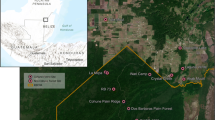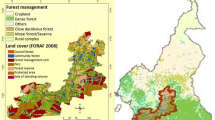Abstract
Montane temperate forests of the Cordillera de Piuchué Ecosystem Study, Isla Chiloé, Chile, are unaffected by air pollution, timber exploitation and agricultural clearing, and the current floristic assemblage has been relatively stable for the past 7500 years. The apparent absence of major perturbation at this location makes it an appropriate baseline site for ecosystem analysis. We measured soil bulk density, pH, soil organic C (SOC), total N, and NH4Cl–exchangeable cations (Ca+2, Mg+2, K+, Na+, Al+3) in 0–10 and 10–40 cm depth samples from 72 soil profiles representing three vegetation zones: Fitzroya cupressoides Forest, Pilgerodendron uvifera–Tepualia stipularis Forest, and Magellanic Moorland. Fitzroya and Pilgerodendron–Tepualia Forests were indistinguishable for all measured soil characteristics (P > 0.05, Dunn's multiple comparison test on ranked data); these included very high median SOC concentrations (0–10 cm = 49.6%) and correspondingly low bulk density values (0–10 cm = 0.07). Moorland soil median values (0-10 cm) were significantly higher for bulk density (0.12) and lower for SOC (28.5%), but not for total N (Forests = 0.99%, Moorland = 0.95%), resulting in lower median C:N ratios for the moorland (Forests = 44.7; Moorland = 30.3). Across both depths and all three vegetation zones regression analysis indicated that SOC was an excellent predictor (R2; = 0.93, P < 0.001) of Σ (exchangeable Ca+2 + Mg+2 + K+ + Na+). Comparison with other old growth montane environments indicates that the Fitzroya and Pilgerodendron–Tepualia soil profiles are characterized by C:N ratios typical of other relatively unpolluted conifer forest soils (33.0–49.3). Soil profiles of representative polluted montane conifer forests have lower C:N ratios (16.2–23.5). Organic horizons from representative polluted montane conifer forests also retain fewer exchangeable base cations per unit SOC than are retained by organic horizons from the Cordillera de Piuchué forests.
Similar content being viewed by others
References
Cole D W and Rapp M 1981 Elemental cycling in forest ecosystems. In Dynamic Properties of Forest Ecosystems. Ed. D E Reichle. pp 341–409. Cambridge University Press, New York.
Dahlquist R L and Knoll, J W 1978 Inductively coupled plasma atomic emission spectrometry: Analysis of biological materials and major trace and ultra-trace elements. Appl. Spectrosc. 32, 1–29.
Hedin L O, Armesto J J and Johnson A H 1995 Patterns of nutrient loss from unpolluted, old-growth temperate forests: Evaluation of biogeochemical theory. Ecology 76, 493–509.
Hedin L O, Granat L, Likens G E, Buishand T A, Galloway J N, Butler T J, Rodhe H 1994 Steep declines in atmospheric base cations in regions of Europe and North America. Nature 367, 351–354.
Holdgate M W 1961 Vegetation and soils in the south Chilean Islands. Ecology 49, 559–580.
Johnson D W and Lindberg S E 1992 Atmospheric Deposition and Forest Nutrient Cycling: A Synthesis of the Integrated Forest Study. Springer-Verlag, New York. 707 p.
Johnson D W, Cressers M S, Nillson S I, Turner J, Ulrich B, Binkley D and Cole D W 1991 Soil changes in forest ecosystems: evidence for and probable causes. Proc. R. Soc. Edinburgh 97B, 81–116.
Kennedy M J, Hedin L O and Derry L A 1996 Unpolluted and undisturbed forests are heavily dependent on atmospheric base cations. Bull. Ecol. Soc. Am. (Suppl.) 77(3), 230.
Levy II H and Moxim W J 1989 Simulated global distribution and deposition of reactive nitrogen emitted by fossil fuel combustion. Tellus 41B, 256–271.
Matzner E and Davis M 1996 Chemical soil conditions in pristine Nothofagus forests of New Zealand as compared to German forests. Plant Soil 186, 285–291.
Miller E K, Huntington T G, Johnson A H and Friedland A J 1992 Aluminum in soil solutions from a subalphine spruce-fir forest at Whiteface Mountain, New York. J. Environ. Qual. 21, 345–352.
Natural Resources Conservation Service 1996 Keys to Soil Taxonomy, 7th ed. United States Department of Agriculture, Washington, D.C.
Perez C, Armesto J J and Ruthsatz B 1991 Descomposición de hojas, biomasa de raíces y características de los suelos en bosques mixtos de coníferas y especies laurifolias en el Parque Nacional Chiloé, Chile. Rev. Chil. Hist. Nat. 64, 479–490.
Prescott C E, Weetman G F, DeMontigny L E, Preston C M and Keenan R J 1995 Carbon chemistry and nutrient supply in cedar-hemlock and hemlock-amabilis fir forest floors. In Carbon Forms and Functions in Forest Soils. Eds. W W McFee and J M Kelly. pp 377–396. Soil Science Society of America, Madison, WI.
Robarge W P and Fernandez I 1987 Quality Assurance Methods for Laboratory Analytical Techniques. Forest Response Program, U.S. Environmental Protection Agency and U.S. Forest Service, Corvallis, OR.
Ruthsatz B and Villagrán C 1991 Vegetation pattern and soil nutrients of a Magellanic moorland on the Cordillera de Piuchué, Chiloé Island, Chile. Rev. Chil. Hist. Nat. 64, 461–478.
Serrano Rojas R M 1996 Contribución de la flora epífita al ciclo de nutrientes de un bosque de alerce en el Parque Nacional Chiloé, Chile. M.Sc. Thesis, Universidad de Chile, Santiago.
SigmaStat 1995 User's Manual, Jandel Corporation, San Rafael, CA.
TableCurve 2D 1994 User's Manual, Jandel Corporation, San Rafael, CA.
Tietema A and Beier C 1995 A correlative evaluation of nitrogen cycling in the forest ecosystems of the EC projects NITREX and EXMAN. For. Ecol. Manage. 71, 143–151.
Vann D R, Palmiotto P A and Strimbeck G R 1998 Allometric equations for two South American conifers: Test of a non-destructive method. For. Ecol. Manage. 106, 55–71.
Villagrán C 1988 Expansion of Magellanic Moorland during the Late Pleistocene: Palynological evidence from northern Isla de Chiloe, Chile. Quart. Res. 30, 304–314.
Villagrán C 1990 Glacial climates and their effects on the history of the vegetation: A synthesis based on palynological evidence from Isla de Chiloe. Rev. Palaeobot. Palyn. 65, 17–24.
Watters W A and Fleming C A 1962 Contributions to the geology and palaeontology of Chiloe Island, southern Chile. Philos. Trans. R. Soc. London 263B, 370–408.
Zarin D J and Johnson A H 1995 Base saturation, nutrient cation, and organic matter increases during early pedogenesis in the Luquillo Experimental Forest, Puerto Rico. Geoderma 65, 317–330.
Author information
Authors and Affiliations
Rights and permissions
About this article
Cite this article
Zarin, D.J., Johnson, A.H. & Thomas, S.M. Soil organic carbon and nutrient status in old-growth montane coniferous forest watersheds, Isla Chiloé, Chile. Plant and Soil 201, 251–258 (1998). https://doi.org/10.1023/A:1004375920790
Issue Date:
DOI: https://doi.org/10.1023/A:1004375920790




